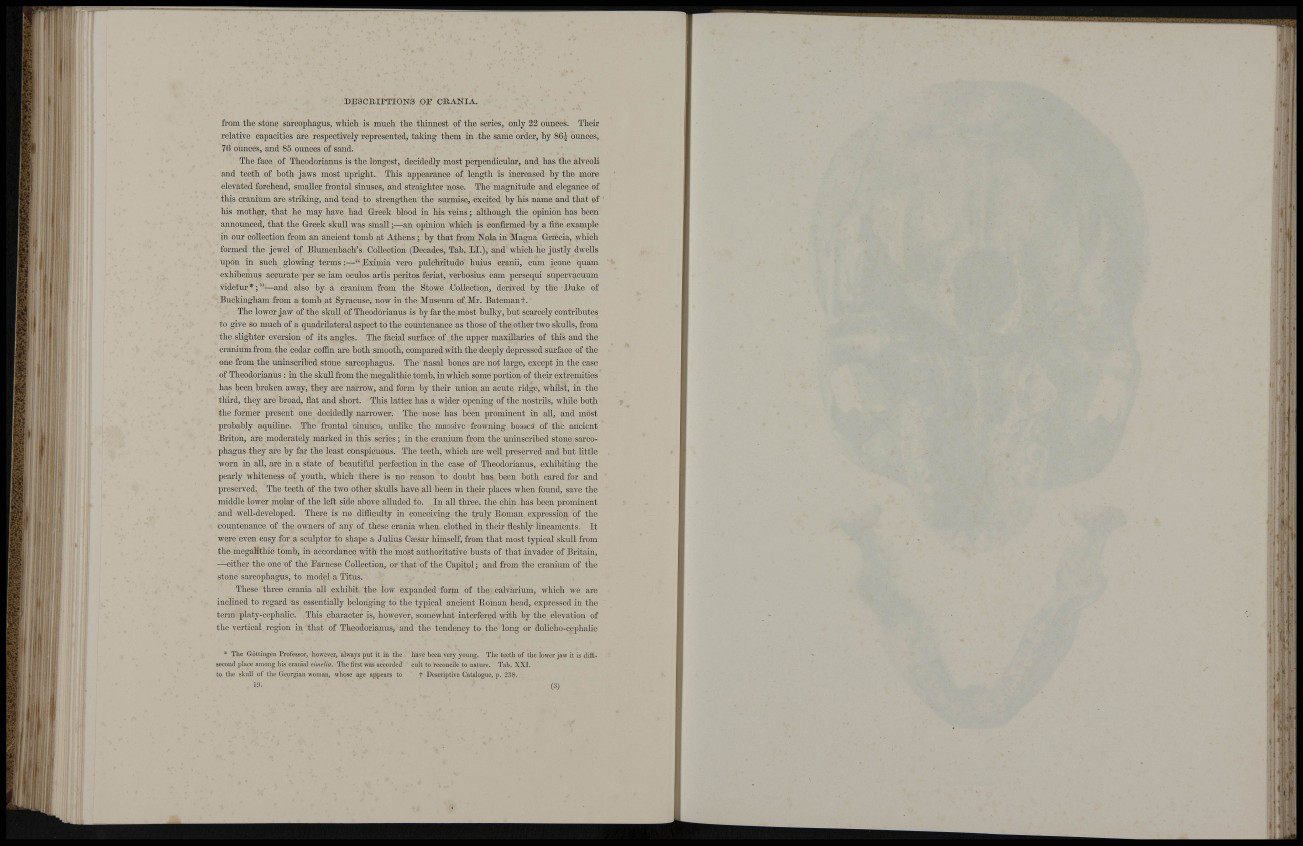
I »IIP '!
, "f:
DESCEIPTIONS OP CRANIA.
from the stone sarcophagus, which is much the thinnest of the series, only 22 ounces. Their
relative capacities are respectively represented, taking them in the same order, by 86-J ounces,
76 ounces, and 85 omices of sand.
The face of Theodorianus is the longest, decidedly most perpendicular, and has the alveoK
and teeth of both jaws most upright. This appearance of length is increased by the more
elevated forehead, smaller frontal sinuses, and straighter nose. The magnitude and elegance of
tliis cranium are striking, and tend to strengthen the sm'mise, excited by his name and that of
his mother, that he may have had Greek blood in his veins; although the opinion has been
announced, that the Greek skull was small;—an opinion which is confirmed by a fine example
in our collection from an ancient tomb at Athens; by that from Nola in Magna GriBcia, which
formed the jewel of Blumenbach's Collection (Decades, Tab. LI.), and which he justly dwells
upon in such glowing terms :—" Eximia vero pulchritudo huius cranii, cum icone quam
exhihemus accurate per se iam oculos artis peritos feriat, verhosius earn persequi supervacuum
videtur*;"—and also by a cranium from the Stowe Collection, derived by the Duke of
Buckingham from a tomb at Syracuse, now in the Museum of Mr. Batemanf.
The lower jaw of the skull of Theodorianus is by far the most bulky, but scarcely contributes
to give so much of a quadrilateral aspect to the countenance as those of the other two skulls, from
the sKghter eversión of its angles. The facial surface of the upper maxillaries of this and the
cranium from the cedar coffin are both smooth, compared with the deej)ly depressed surface of the
one from the uninscribed stone sarcophagus. The nasal bones are not large, except in the case
of Theodorianus : in the skull fr-om the megahthic tomb, in which some portion of their extremities
has been broken away, they are narrow, and form by their union an acute ridge, whüst, in the
third, they are broad, flat and short. This latter has a wider opening of the nostrils, while both
the former present one decidedly narrower. The nose has been prominent in aU, and most
probably aquiline. The frontal sinuses, unlike the massive frowning bosses of the ancient
Briton, are moderately marked in this series; in the cranium fr-om the uninscribed stone sarcophagus
they are by far the least conspicuous. The teeth, which are well preserved and but little
worn in all, are in a state of beautiful perfection in the case of Theodorianus, exhibiting the
pearly whiteness of youth, which there is no reason to doubt has been both cared for and
preserved. The teeth of the two other skulls have all been in their places when found, save the
middle lower molar of the left side above alluded to. In all three, the chin has been prominent
and weU-developed. There is no difficulty in conceiving the truly Roman expression of the
countenance of the o-vvners of any of these crania when clothed in their fleshly lineaments. It
were even easy for a sculptor to shape a Julius Csesar himself, from that most typical skuU from
the megaKthic tomb, in accordance with the most authoritative busts of that invader of Britain,
—either the one of the Earnese Collection, or that of the Capitol; and fr-om the craniimi of the
stone sarcophagus, to model a Titus.
These three crania aU exhibit the low expanded form of the calvarium, which we are
inclined to regard as essentially belonging to the typical ancient Roman head, expressed in the
term platy-cephalic. This character is, however, somewhat interfered with by the elevation of
the vertical region in that of Theodorianus, and the tendency to the long or dolicho-ccphalic
* The Gottiiigen Professor, however, always put it in the have been very young. The teeth of the lower jaw it is diffiseeoud
place among his cranial dmelia. The first was accorded cult to reconcile to nature. Tab. XXI.
to the skull of the Georgian woman, whose age appears to f Descriptive Catalogue, p. 238.
13. (3)
m;
If <ii: ri :
'T !
'Oil''
1
wli'
! -ii •
m:
p i i^'!'
T i l ' : !
ilita!
1Í4